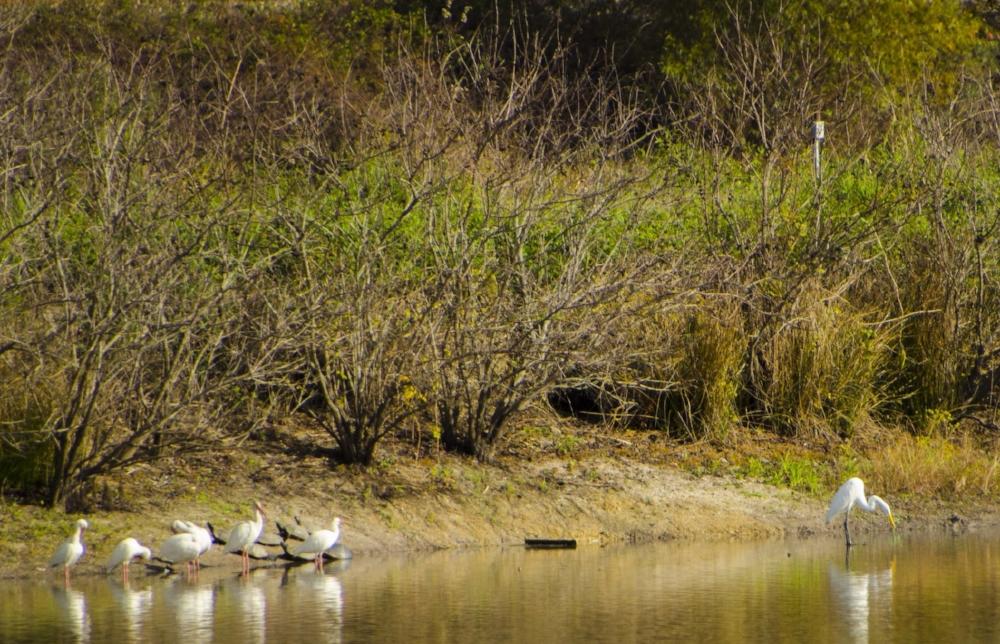This article first appeared in the South Carolina Natural Resources Blog.
Even amateur photographers and birdwatchers can score big at the Audubon South Carolina Center in Silver Bluff.
The sign says “Sanctuary,” and it sure does feel that way. Just a few miles after the turn off of S.C. 125 (the “Atomic Highway”) near the town of Jackson (home of the annual “Hook and Cook” fishing tournament and fish-fry), the pavement on Silver Bluff Road ends and a sandy dirt lane with woods and fields and planted pines on either side takes over. At the end of this idyllic-feeling drive through the woods, you’ll find Audubon South Carolina’s 3,00-plus acre property near the Savannah River. It’s a beautiful spot, and on a cool but sunny late fall day-trip visit, I’m looking forward to a leg-stretching hike and seeing some birds or other wildlife.
Geographically speaking, this is the very upper edge of the coastal plain, very close to the Fall Line, but it’s also square in the heart of “Thoroughbred Country,” the tourism region that includes Aiken, Allendale, Bamberg and Barnwell counties, where horses, history and hospitality seem to go together. I’ve been this way before, “over the river and through the woods” early on a Thanksgiving morning on my way to Aiken for the annual “Blessing of the Hounds” in the Hitchcock Woods – a truly great time if you’ll be in the vicinity on this coming Thanksgiving – but today I’m striking out on a different adventure, hoping to see some bird life at Silver Bluff and log a few miles on their well-maintained nature trail in anticipation of the month-long festival of holiday calories just over the horizon.
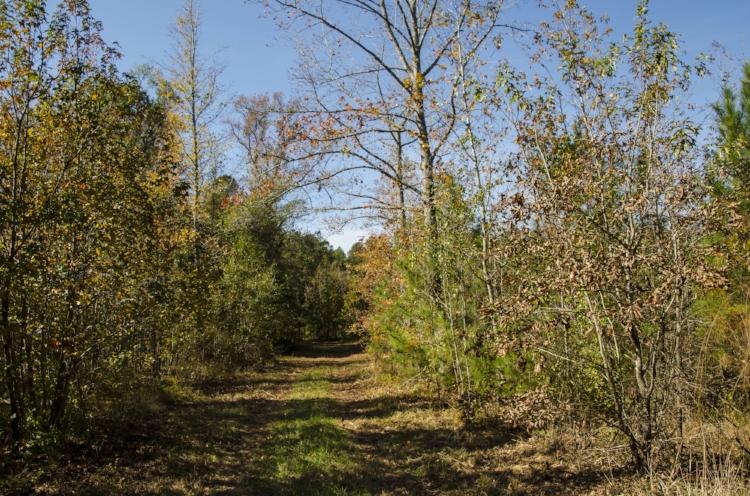
There’s actually two trails you can take at the Sanctuary, as well as two ponds that provide a home for many species waterfowl and wading birds, including federally endangered wood storks. In all, it’s entirely possible to see more than 200 individual species of birds at Silver Bluff, depending on the season(s) you visit. And here’s the thing: if you’re a dedicated birder and/or nature photographer, I’m not telling you anything you don’t already know. Those folks are already well-familiar with this place and what it offers. I have seen the photos, and they are awesome. I was eager to check it out, and what I found was that the truly thing about this place is that the bird life is so abundant that even an average-to-middling photographer like me (or you) can still get some pretty decent shots, even without packing a heavy (and expensive) 600 mm lens and tripod. You can do pretty well with just a consumer-level SLR (I shoot a Nikon D-5100) and a smaller variable lens. If you have one, a lightweight tripod would be an excellent thing to take along.
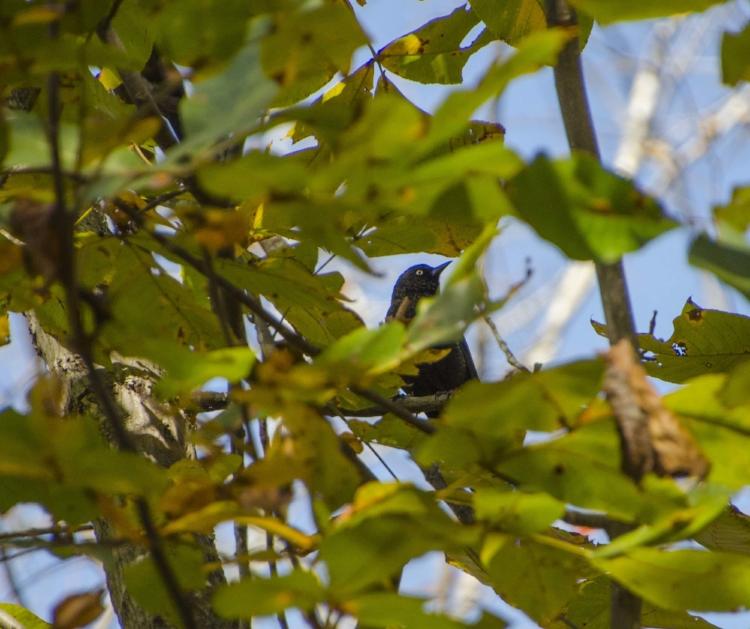
For a quick outing, the three-quarter-mile-long “Nuthatch Trail” loop will take you through some of the sanctuary’s pine-dominated uplands. I got there pretty early (the gates/trails are typically open Monday—Saturday, 9 a.m. to 5 p.m.), and with all morning to explore, I decided to try the longer (two-mile) “Tanager Trail” loop. I’m glad I did. The varied terrain cover on the loop was interesting, and the boardwalk located near the mid-point of the loop turned out to be a hidden gem – a beautiful spot at the head of a hard-wood and cypress filled drain that was teeming with bird life.
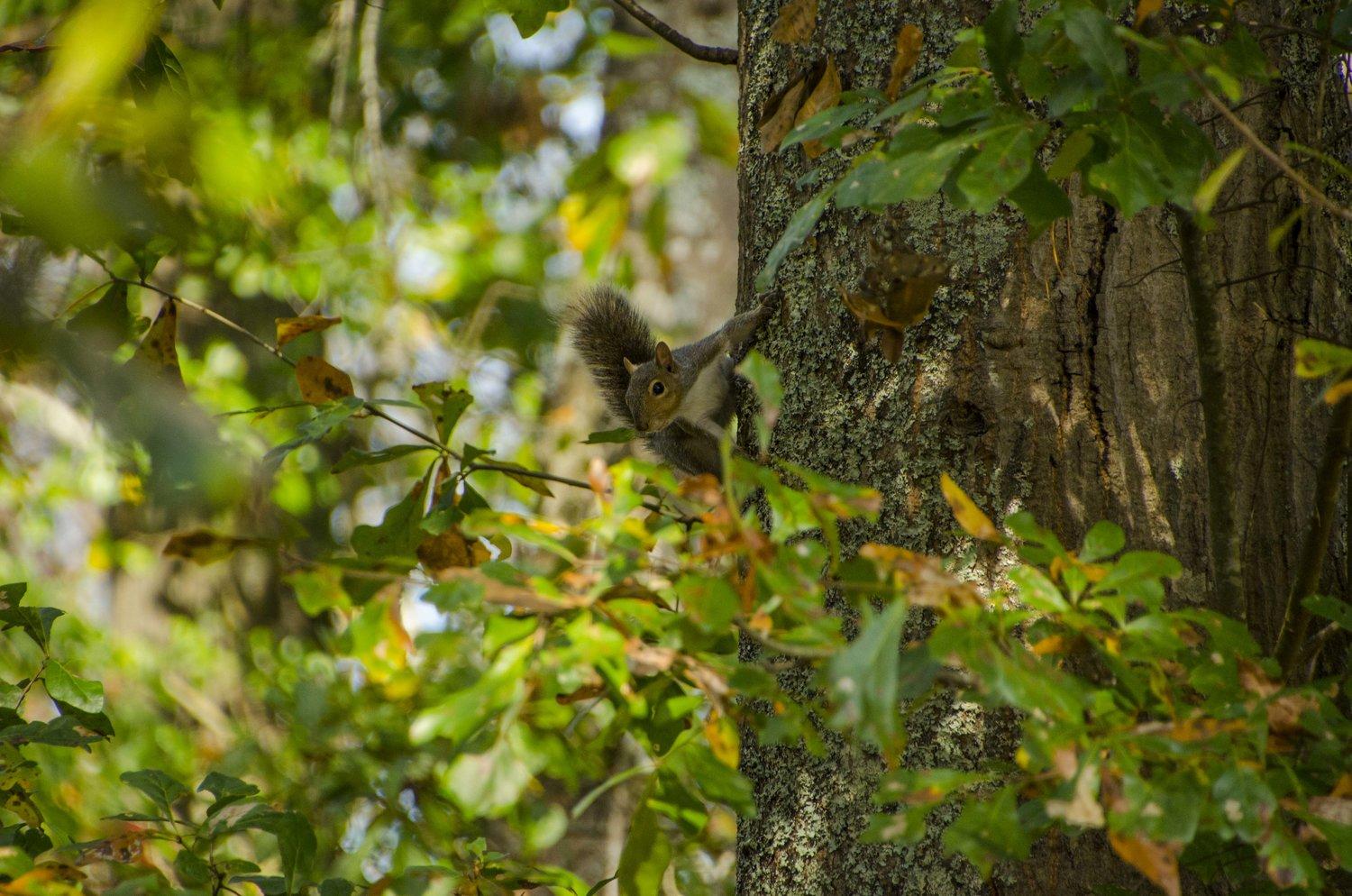
To get there, simply start at the ample grass parking lot and after checking out the signage, follow the trail markers. The trail winds along a powerline adjacent to the dirt road headed into the sanctuary parking lot. I wasn’t really sure how active or abundant the bird life would be in mid-November, but I needn’t have worried. Almost as soon as I left the parking lot the songs and calls from various species began ringing out. It was loud! I’m no stranger to the woods, but the abundance of birdlife here was very apparent. There are A LOT of birds at this place, I thought. I passed some strategically located benches in the Uplands portion, which probably would have been good spots to stop and watch for awhile, but I decided to press on. Winding down the hill in the eventual direction of the river, near the turnoff to the boardwalk, the mad manic chattering of a pair of squirrels that had been dogging my steps for awhile gave way to a fast rat-a-tat knocking. I spotted a pair of pileated woodpeckers working the hardwoods about 50-75 yards into the woods. I waited for a short time, but I could never get a good shot. If I had more time on a return trip, though, that corner, and the 100-or-so yards approaching it, would definitely be a spot to sit and watch awhile.
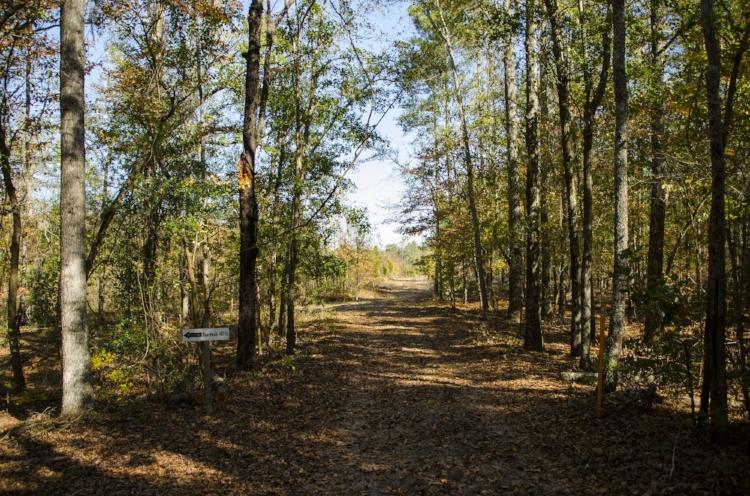
Instead, I pressed on towards the boardwalk. The trail here is lined with wild dogwoods, and the red berries littered the ground and hung at the tips of tree branches. A feast ready for the taking, which the local wildlife was obviously taking advantage of. The boardwalk itself was covered in a freshly-fallen carpet of leaves, leading to an absolutely beautiful spot. By now the day was getting warm, and I had worked up a little bit of a sweat on the upper part of the trail. Here though, at the end of the boardwalk, it was cool, shady and quiet and someone had thoughtfully built a pair of benches long enough to stretch out and prop up one’s legs. I sat, enjoying the stillness and watching a pair of bluebirds busily flitting in and out of a knothole high up in an oak tree. I was thinking about a nap, (and, to tell you the truth, what a great deer hunting spot this would be,) and I was already about halfway there, my mind wandering and getting into that waking dream state that only seems to happen when you’re sitting in the woods, when a flicker came by to see what was so interesting in the knothole, and a throw-down in bird town commenced, for a little while, with the excited bluebirds ganging up on the curious flicker.
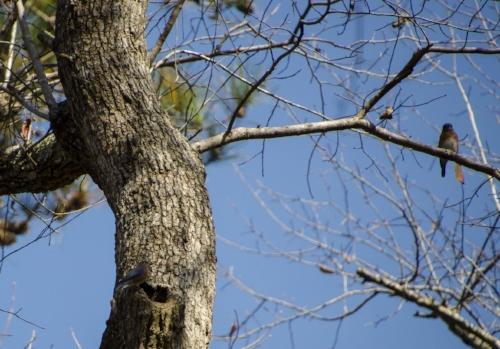

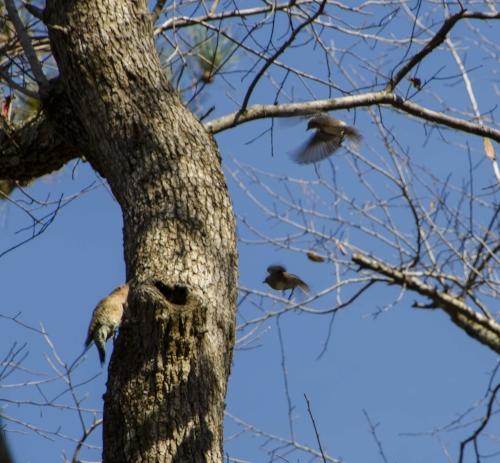
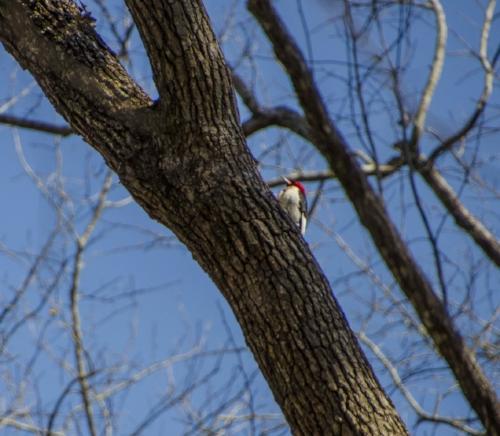
I hated to leave, but, reverie interrupted, I shook off my inclination to nap the day away and decided to move on. Back on the loop, the trail followed the edge of the drain for a while, with an old cutover coming up in young pines on the other side. It was easy to see that this area would be a great place to set up for some serious birdwatching or photography, with birds traveling between the relatively open field and the shady bottomlands stretching into the other side. Deer tracks were abundant here as well, and the dogwoods – those trees love a field border – were just laden with berries. I didn’t go very far at all before a cooperative yellow bird (a female goldfinch, perhaps?) insisted on posing for a photo.

Back at the parking lot, I watched a group of school children pile out of their bus and into the sanctuary’s education center – it’s a popular spot for field trips – and packed up my gear, ready to make my way to stop number two on my day’s itinerary, the Healing Springs near Blackville. On the way out though, I couldn’t resist taking a look at the ponds, where I was pleasantly surprised to find a number of ducks and wading birds hanging out. I took some pictures, but this is a case where a little more preparation would have been useful. A pair of buffleheads scattered as soon as I walked up on the dike of the first pond, and it was tough to get close enough to other birds with my 80-300mm lens without spooking them as well. NEXT time, I’ll come prepared with a bit more lens – maybe a 400mm and a heavy tripod. That rig could be deployed for some awesome sharp close-up shots both at the boardwalk and the ponds.
